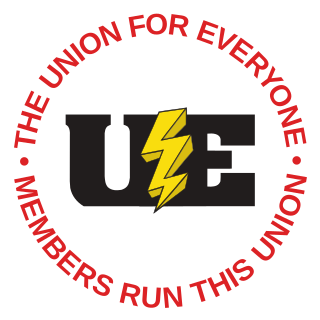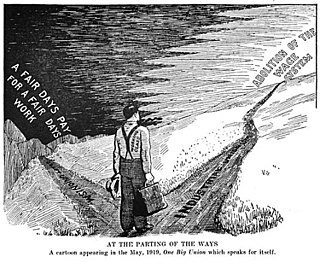
The National Labor Relations Act of 1935, also known as the Wagner Act, is a foundational statute of United States labor law that guarantees the right of private sector employees to organize into trade unions, engage in collective bargaining, and take collective action such as strikes. Central to the act was a ban on company unions. The act was written by Senator Robert F. Wagner, passed by the 74th United States Congress, and signed into law by President Franklin D. Roosevelt.

The Solidarity Federation is a British anarcho-syndicalist political organisation. It advocates for the abolition of capitalism and the state through industrial action, which it agitates for in industrial networks and local groups.

The 1936–1937 Flint sit-down strike, also known as the General Motors sit-down strike, or the great GM sit-down strike, was a sitdown strike at the General Motors plant in Flint, Michigan, United States. It changed the United Automobile Workers (UAW) from a collection of isolated local unions on the fringes of the industry into a major labor union, and led to the unionization of the domestic automobile industry.
Robert Staughton Lynd was an American sociologist and professor at Columbia University, New York City. He is best known for conducting the first Middletown studies of Muncie, Indiana, with his wife, Helen Lynd; as the coauthor of Middletown: A Study in Contemporary American Culture (1929) and Middletown in Transition: A Study in Cultural Conflicts (1937); and a pioneer in the use of social surveys. He was also the author of Knowledge for What? The Place of the Social Sciences in American Culture (1939). In addition to writing and research, Lynd taught at Columbia from 1931 to 1960. He also served on U.S. government committees and advisory boards, including President Herbert Hoover's Research Committee on Social Trends and President Franklin D. Roosevelt's Consumers' Advisory Board of the National Recovery Administration. Lynd was also a member of several scientific societies.

A sit-down strike is a labour strike and a form of civil disobedience in which an organized group of workers, usually employed at factories or other centralized locations, take unauthorized or illegal possession of the workplace by "sitting down" at their stations. By taking control of their workplaces, workers engaged in a sit-down demonstrate their power, build solidarity among themselves, prevent the deployment of strikebreakers or removal of industrial equipment, and cause cascading effects on the chain of production within and between factories. However, sit-down strikes are illegal in the vast majority of countries, complicating their use.

The United Electrical, Radio and Machine Workers of America (UE), is an independent democratic rank-and-file labor union representing workers in both the private and public sectors across the United States.
Staughton Craig Lynd was an American political activist, author, and lawyer. His involvement in social justice causes brought him into contact with some of the nation's most influential activists, including Howard Zinn, Tom Hayden, A. J. Muste, and David Dellinger.

Labor unions represent United States workers in many industries recognized under US labor law since the 1935 enactment of the National Labor Relations Act. Their activity centers on collective bargaining over wages, benefits, and working conditions for their membership, and on representing their members in disputes with management over violations of contract provisions. Larger labor unions also typically engage in lobbying activities and electioneering at the state and federal level.
Martin Glaberman was an American Marxist writer on labor, historian, academic, and autoworker.
The Progressive Miners of America was a coal miners' union organized in 1932 in Gillespie, Illinois. It was formed in response to a 1932 contract proposal negotiated by United Mine Workers President John L. Lewis, which reduced wages from a previous rate of $6.10 per day to $5.00 per day.
The Steel Workers Organizing Committee (SWOC) was one of two precursor labor organizations to the United Steelworkers. It was formed by the CIO on June 7, 1936. It disbanded in 1942 to become the United Steel Workers of America. The Steel Labor was the official paper of SWOC.
The Chinese Staff and Worker's Association (CSWA) is a nonprofit, nonpartisan workers' rights organization based in New York City which educates and organizes workers in the United States so that they may improve their working conditions. It primarily assists workers in restaurants, the garment and construction industries, although it is active among workers in a variety of professions. The organization serves workers from all backgrounds, most of its members are Chinese and most of its efforts directed at employers in Chinatown.
Solidarity unionism is a model of labor organizing in which the workers themselves formulate strategy and take action against the company directly without mediation from government or paid union representatives. The term originated in a 1978 book Labor Law for the Rank and Filer by Staughton Lynd who described a model of organizing promoted in the early 20th century by the Industrial Workers of the World which eschews the formality and bureaucracy of government-recognized unions, which Lynd and co-author Daniel Gross refer to as "business unions."

The Industrial Workers of the World (IWW) is a union of wage workers which was formed in Chicago in 1905 by militant unionists and their supporters due to anger over the conservatism, philosophy, and craft-based structure of the American Federation of Labor (AFL). Throughout the early part of the 20th century, the philosophy and tactics of the IWW were frequently in direct conflict with those of the AFL concerning the best ways to organize workers, and how to best improve the society in which they toiled. The AFL had one guiding principle—"pure and simple trade unionism", often summarized with the slogan "a fair day's pay for a fair day's work." The IWW embraced two guiding principles, fighting like the AFL for better wages, hours, and conditions, but also promoting an eventual, permanent solution to the problems of strikes, injunctions, bull pens, and union scabbing.

Andrej Grubačić is a Yugoslav world historian, world-systems theorist, and activist based in the United States.
Lewis Samuel Feuer was an American sociologist. Initially a committed Marxist, he became a neo-conservative.
Stan Weir (1921–2001) was an influential blue-collar intellectual, socialist, and labor leader. A rank-and-file worker for most of his life, Weir worked as a seaman in the Merchant Marine during World War II, as an auto worker, longshoreman, truck driver, and painter, before taking a position at the University of Illinois, where he taught courses to union locals.
Hess v. Indiana, 414 U.S. 105 (1973), was a United States Supreme Court case involving the First Amendment that reaffirmed and clarified the imminent lawless action test first articulated in Brandenburg v. Ohio (1969). Hess is still cited by courts to protect speech threatening future lawless action.
The Great Unrest, also known as the Great Labour Unrest, was a period of labour revolt between 1911 and 1914 in the United Kingdom. The agitation included the 1911 Liverpool general transport strike, the Tonypandy riots, the National coal strike of 1912 and the 1913 Dublin lockout. It was United Kingdom's most significant labour unrest since the Industrial Revolution but is not as widely remembered as the 1926 general strike. The period of unrest was labelled "great" not because of its scale, but due to the level of violence employed by both the state and labourers; including deaths of strikers at the hands of police and sabotage on the part of the workers.
Jesse Reese, was a black communist and militant trade unionist in the United States.








